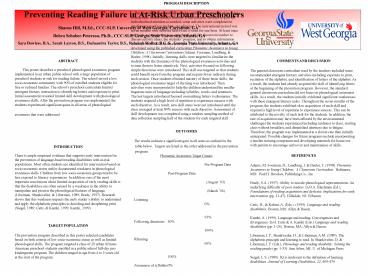ABSTRACT - PowerPoint PPT Presentation
1 / 1
Title: ABSTRACT
1
Preventing Reading Failure in At-Risk Urban
Preschoolers
Sharon Hill, M.Ed., CCC-SLP, University of West
Georgia, Carrollton, GA Debra Schober-Peterson,
Ph.D., CCC-SLP, Georgia State University,
Atlanta, GA Sara Dowless, B.A., Sarah Layton,
B.S., DaJuandra Taylor, B.S., Rebekah Walker,
B.G. S., Georgia State University, Atlanta, GA
- PROGRAM DESCRIPTION
- The phonological awareness activities were
implemented in class using a circle time format
already familiar to the children. In order to
provide individualized attention as needed, some
activities were completed in smaller groups of
ten students per clinician. The instructional
period was seven months with sessions held twice
a week for one hour. At least once per week, a
consultation was completed with the classroom
teacher to discuss activity ideas, the students
progress, and to obtain information on carryover
of skills in the classroom. The instructional
activities were developed using the published
curriculum Phonemic Awareness in Young Children
A Classroom Curriculum (Adams, Foorman, Lundberg,
Beeler, 1998). Initially, listening skills were
targeted to familiarize the students with the
dynamics of the phonological awareness activities
and to train them to listen attentively. Next,
activities focused on following simple directions
were introduced. This skill was targeted so that
students could benefit more from the program and
require fewer redirects during each session. Once
students obtained mastery of these basic skills,
the phonological awareness target of rhyming was
introduced. Then activities were incorporated to
help the children understand the smaller
linguistic units of language including syllables,
words, and sentences. The last targets introduced
focused on matching letters to phonemes. The
students required a high level of repetition to
experience success with each objective. As a
result, new skill areas were not introduced until
the class averaged at least 80 success with each
objective. Assessment of skill development was
completed using a random sampling method of data
collection sampling half of the students for each
targeted skill. - OUTCOMES
- The results indicate a significant gain in all
areas as outlined in the - table below. Targets are listed in the order
addressed in the prevention - program.
- Phonemic Awareness Target Games
- Pre-Program Data Post-Program Data
- (August 05) (March 06)
- Listening 0 93
- Following directions 50 100
- Rhyming 60 100
- Awareness of syllables 0 90
ABSTRACT This poster describes a preschool
phonological awareness program implemented in an
urban public school with a large population of
preschool students at-risk for reading failure.
The school served a low socio-economic community
with 90 of enrolled students eligible for free
or reduced lunches. The schools preschool
curriculum limited emergent literacy instruction
to identifying letters and exposure to print.
Initial assessment revealed limited skill
development with phonological awareness skills.
After the prevention program was implemented, the
students experienced significant gains in all
areas of phonological awareness that were
addressed. INTRODUCTION There is ample
empirical evidence that supports early
intervention for the prevention of language-based
reading disabilities with at-risk populations.
Most often students are identified for
intervention based on socio-economic status
and/or documented weakness in phonological
awareness skills. Children from low
socio-economic groups tend to be less exposed to
literacy experiences. In addition, one of the
most important conclusions about limited
acquisition of early reading skills is that the
disabilities are often caused by a weakness in
the ability to manipulate and process the
phonological features of language (Liberman,
Shankweiler, Liberman, 1989 Brady, 1997).
Research shows that this weakness impacts the
early readers ability to understand and apply
the alphabetic principles to decoding and
deciphering print (Siegel, 1989 Catts, Kamhi,
1999 Kamhi, 1999). TARGET POPULATION The
prevention program described in this poster
selected candidates based on both criteria of low
socio-economic status as well as limited
phonological skills. The program targeted a class
of 20 urban African-American preschool students
enrolled in a public school full-day
pre-kindergarten program. The children ranged in
age from 4 to 5 years old at the start of the
program.
COMMENTS AND DISCUSSION The general classroom
curriculum used by the teachers included some
recommended emergent literacy activities
including exposure to print, recitation of the
alphabet, and identification of letters of the
alphabet. As a result, the students had already
acquired the skill of identifying letters at the
beginning of the prevention program. However, the
standard general classroom curriculum did not
focus on phonological awareness skills. As a
result, the students initially exhibited
significant weaknesses with these emergent
literacy tasks. Throughout the seven months of
the program, the students exhibited slow
acquisition of each skill and required a high
level of repetition to experience success. This
can be attributed to the novelty of each task for
the students. In addition, the rate of
acquisition may have been affected by the
environmental challenges the students experienced
including tardiness to class, starting class
without breakfast, and diminished alertness due
to fatigue. Therefore, the program was
implemented at a slower rate than initially
anticipated. Possible changes for future programs
include incorporating a teacher training
component and developing materials for home use
with parents to encourage carryover and
maintenance of skills. REFERENCES Adams, M.
Foorman, B., Lundberg, I. Beeler, T. (1998).
Phonemic Awareness in Young Children A
Classroom Curriculum. Baltimore, MD Paul H.
Brookes, Publishing Co., Inc. Brady, S.A.
(1997). Ability to encode phonological
representations An underlying difficulty of poor
readers. In B.A. Blachman (Ed.), Foundations of
reading acquisition and dyslexia Implications
for early intervention (pp. 21-47). Hillsdale,
NJ Erlbaum. Catts, H., Kahmi, A. (Eds.).
(1999). Language and reading disabilities.
Boston, MA Allyn Bacon. Kamhi, A. (1999).
Language and reading Convergences and
divergences. In H. Catts A. Kamhi (Eds.)
Language and reading disabilities (pp. 1-24).
Boston, MA Allyn Bacon. Liberman, I.Y.,
Shankweiler, D., Liberman, A.M. (1989). The
alphabetic principle and learning to read. In
Shankweiler, D. Liberman, I.Y. (Eds.),
Phonology and reading disability Solving the
reading puzzle (pp. 1-33). Ann Arbor, MI U. of
Michigan Press. Seigel, L.S. (1989). IQ is
irrelevant to the definition of learning
disabilities. Journal of Learning Disabilities,
22, 469-479.

